
The New York Times fudged book sales data in order to deny top-five billing to the best-selling “Justice on Trial,” the definitive and deeply reported account of the nomination and confirmation of Supreme Court Justice Brett Kavanaugh, which was written by Carrie Severino and Mollie Hemingway, a Senior Editor for The Federalist. Industry sales figures show that the New York Times ignored actual data on nationwide sales in order to depress the rankings not just for the Hemingway/Severino book, but also Mark Levin’s latest book on the corruption of modern journalism.
According to Publisher’s Weekly, the only public source of point-of-sale data on book sales, “Justice on Trial,” was the top-selling non-fiction book published over the last week. Tara Westover’s blockbuster memoir “Educated” was the top-selling non-fiction overall according to data from NPD Bookscan, but is excluded from Publisher’s Weekly’s list since it was first published over a year ago.
Mark Levin’s “Unfreedom of the Press” came in at #2 on the best-selling list, followed by David McCullough’s “The Pioneers” at #3, “Three Women” by Lisa Taddeo at #4, and Michelle Obama’s “Becoming” at #5. Hemingway’s and Severino’s book outsold each of those books placed ahead of it on the New York Times list, according to nationwide sales data.
Amazon.com, the online retail giant, reported that “Justice on Trial” was also the top-selling non-fiction book on its site last week. It was Amazon’s top-selling book overall, non-fiction or otherwise, from Monday through Friday of last week.
The New York Times, however, reported a very different ranking at complete odds with the Publisher’s Weekly/NPD Bookscan sales figures. Instead of accurately reporting that “Justice on Trial” was the second best-selling hardcover non-fiction book in America last week according to widely accepted industry sales data, the New York Times put the book at #6 on its list, behind Mark Levin’s book at #5. Neither ranking can be justified by actual sales figures.
In fact, a comparison of rankings based on sales figures and the New York Times list shows a massive discrepancy between reality and what the editors of the New York Times list apparently wish to be true. For example, six of the top 15 best-sellers by actual sales are entirely absent from the Times list.
The New York Times similarly boosted books by left-wing authors and placed them on the list despite sales figures showing much lower rankings. An anti-Trump book by left-wing activist Joy Reid of MSNBC, for example, was placed on the New York Times list at #15, despite sales figures showing that it was barely the 25th best-selling non-fiction book in the country last week with fewer than 3,200 books sold. Despite selling nearly 10 percent more books than Reid, a new book by right-wing TV personality Tomi Lahren was left off the New York Times list.
Bias by the New York Times isn’t just evident in its arbitrary rankings. The editors also used loaded words and warnings to urge its readers to avoid books from authors who aren’t sufficiently left-wing. Political modifiers were used for conservative writers, but not for liberal ones. Mark Levin, for example, is a “conservative commentator.” Hemingway and Severino are “conservative authors.” Joy Reid, however, is just an “MSNBC host.” Loaded language was also used to describe the books themselves.
Levin’s book is “his case” that media are politically biased, and the exhaustively reported book by Hemingway and Severino that is based on over 100 interviews with nearly every single key player involved in the Kavanaugh confirmation process is merely “their take” on what went down last summer. In contrast, Taddeo’s book “Three Women” is a straightforward study of “the inequality of female desire…explored through the sex lives of a homemaker, a high school student and a restaurant owner.”
Well-founded accusations of rank bias and manipulation have dogged the New York Times Best Seller List for years. In 1983, William Blatty, the best-selling author of “The Exorcist” sued the New York Times for ignoring sales data and leaving him off its list, alleging that the paper had economically harmed him through its dishonest curation and marketing of its list. While the Supreme Court eventually dismissed Blatty’s case, it did not do so on the basis of the accuracy or veracity of the New York Times list. As literary historian Laura J. Miller noted at the time, the New York Times did not even lean on truth as its primary defense in the case.
“The Times defended itself by saying that contrary to Blatty’s assertion, the list did not purport to be an objective compilation of information but instead was an editorial product,” Miller concluded. “This was the argument that prevailed in the courts.”
The New York Times was also blasted earlier this year for including Valerie Jarrett’s book on its list during its debut week despite the fact that the book sold next to no copies. At the time her book was included on the New York Times list, it wasn’t even ranked in the top 1,000 books on Amazon. It didn’t even crack the top 1,200 books sold by Barnes and Noble, according to a Daily Caller analysis.
Rather than collecting nationwide data on book sales across all platforms and locations, the New York Times reportedly surveys only select retailers, the identities of which the paper refuses to disclose.
In a 2007 column, former public editor Clark Hoyt all but admitted that the New York Times Best Seller list was fake news.
The list “is not a completely accurate barometer of what the reading public is buying,” Hoyt wrote. “For my money, if the main list is a best sellers list, it ought to reflect what’s selling best.”









